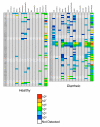Detection and quantification of 14 Campylobacter species in pet dogs reveals an increase in species richness in feces of diarrheic animals
- PMID: 20219122
- PMCID: PMC2848019
- DOI: 10.1186/1471-2180-10-73
Detection and quantification of 14 Campylobacter species in pet dogs reveals an increase in species richness in feces of diarrheic animals
Abstract
Background: The genus Campylobacter includes many species, some of which are known human and animal pathogens. Even though studies have repeatedly identified domestic dogs as a risk factor for human campylobacteriosis, our understanding of Campylobacter ecology in this reservoir is limited. Work to date has focused primarily on a limited number of species using culture-based methods. To expand our understanding of Campylobacter ecology in dogs, a collection of fecal samples from 70 healthy and 65 diarrheic pet dogs were examined for the presence and levels of 14 Campylobacter species using quantitative PCR.
Results: It was found that 58% of healthy dogs and 97% of diarrheic dogs shed detectable levels of Campylobacter spp., with C. coli, C. concisus, C. fetus, C. gracilis, C. helveticus, C. jejuni, C. lari, C. mucosalis, C. showae, C. sputorum and C. upsaliensis levels significantly higher in the diarrheic population. Levels of individual Campylobacter species detected ranged from 103 to 108 organisms per gram of feces. In addition, many individual samples contained multiple species of Campylobacter, with healthy dogs carrying from 0-7 detectable species while diarrheic dogs carried from 0-12 detectable species.
Conclusions: These findings represent the largest number of Campylobacter species specifically tested for in animals and is the first report to determine quantifiable levels of Campylobacter being shed from dogs. This study demonstrates that domestic dogs can carry a wide range of Campylobacter species naturally and that there is a notable increase in species richness detectable in the diarrheic population. With several of the detected Campylobacter species known or emerging pathogens, these results are relevant to both ecological and public health discussions.
Figures



Similar articles
-
Occurrence and species level diagnostics of Campylobacter spp., enteric Helicobacter spp. and Anaerobiospirillum spp. in healthy and diarrheic dogs and cats.Vet Microbiol. 2008 Jun 22;129(3-4):304-14. doi: 10.1016/j.vetmic.2007.11.014. Epub 2007 Nov 22. Vet Microbiol. 2008. PMID: 18164874
-
Development of cpn60-based real-time quantitative PCR assays for the detection of 14 Campylobacter species and application to screening of canine fecal samples.Appl Environ Microbiol. 2009 May;75(10):3055-61. doi: 10.1128/AEM.00101-09. Epub 2009 Mar 20. Appl Environ Microbiol. 2009. PMID: 19304828 Free PMC article.
-
Detection of Campylobacter upsaliensis in diarrheic dogs and cats, using a selective medium with cefoperazone.Am J Vet Res. 1992 Jan;53(1):48-51. Am J Vet Res. 1992. PMID: 1539914
-
Campylobacteriosis in dogs and cats: a review.N Z Vet J. 2018 Sep;66(5):221-228. doi: 10.1080/00480169.2018.1475268. Epub 2018 May 23. N Z Vet J. 2018. PMID: 29756542 Review.
-
Bacterial-associated diarrhea in the dog: a critical appraisal.Vet Clin North Am Small Anim Pract. 2003 Sep;33(5):1029-60. doi: 10.1016/s0195-5616(03)00091-3. Vet Clin North Am Small Anim Pract. 2003. PMID: 14552160 Review.
Cited by
-
The chaperonin-60 universal target is a barcode for bacteria that enables de novo assembly of metagenomic sequence data.PLoS One. 2012;7(11):e49755. doi: 10.1371/journal.pone.0049755. Epub 2012 Nov 26. PLoS One. 2012. PMID: 23189159 Free PMC article.
-
Presence of Campylobacterjejuni and C. coli in Dogs under Training for Animal-Assisted Therapies.Int J Environ Res Public Health. 2021 Apr 2;18(7):3717. doi: 10.3390/ijerph18073717. Int J Environ Res Public Health. 2021. PMID: 33918252 Free PMC article.
-
First report of severe acute otitis media caused by Campylobacter rectus and review of the literature.J Infect Chemother. 2016 Dec;22(12):800-803. doi: 10.1016/j.jiac.2016.06.001. Epub 2016 Jun 28. J Infect Chemother. 2016. PMID: 27363873 Free PMC article.
-
Environmental contamination by dog’s faeces: a public health problem?Int J Environ Res Public Health. 2012 Dec 24;10(1):72-84. doi: 10.3390/ijerph10010072. Int J Environ Res Public Health. 2012. PMID: 23263659 Free PMC article.
-
Investigation of the enteric pathogenic potential of oral Campylobacter concisus strains isolated from patients with inflammatory bowel disease.PLoS One. 2012;7(5):e38217. doi: 10.1371/journal.pone.0038217. Epub 2012 May 30. PLoS One. 2012. PMID: 22666490 Free PMC article.
References
-
- WHO. Fact Sheet No. 255: Campylobacter. Geneva: (WHO); 2000.
-
- Bowman C, Flint J, Pollari F. Canadian integrated surveillance report: Salmonella, Campylobacter, pathogenic E. coli and Shigella, from 1996 to 1999. Canada Communicable Dis Report. 2003;29(Suppl 1(1)) i-vi, 1-32. - PubMed
-
- Samuel MC, Vugia DJ, Shallow S, Marcus R, Segler S, McGivern T, Kassenborg H, Reilly K, Kennedy M, Angulo F. Epidemiology of sporadic Campylobacter infection in the United States and declining trend in incidence, FoodNet 1996-1999. Clin Infect Dis. 2004;38(Suppl 3):S165–174. doi: 10.1086/381583. - DOI - PubMed
Publication types
MeSH terms
Substances
LinkOut - more resources
Full Text Sources
Medical
Miscellaneous

